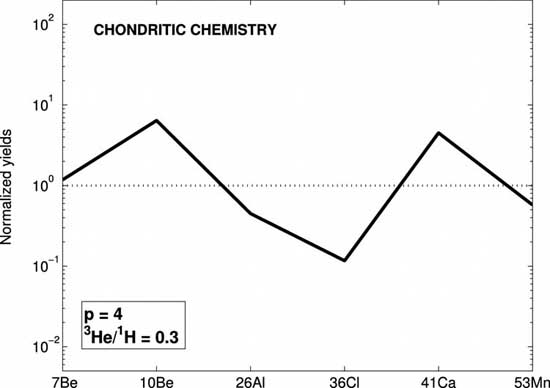Yields of 7Be, 10Be, 26Al, 36Cl, 41Ca, and 53Mn for a chondritic chemistry and the spectral parameters p = 4 and 3He/1H = 0.3

Yields of 7Be, 10Be, 26Al, 36Cl, 41Ca, and 53Mn for a chondritic chemistry and the spectral parameters p = 4 and 3He/1H = 0.3. The yields are normalized to the experimental values, corresponding to the horizontal dotted line. For 41Ca, we have adopted the initial value 41Ca/40Ca = 3.9×10-7, more likely than the canonical ratio.
By modeling the abundance of radioactive elements found in calcium-aluminum-rich inclusions (CAIs) of meteorites, the origin and the evolution of the solar nebula is gradually being unraveled. Two explanations exist for the short-lived radionuclides (half-life T1/2 < 5 Myr) present in the solar system when CAIs first formed. They originated either from the ejecta of a supernova or by the in situ irradiation of nebular dust by energetic particles. With a half-life of only 53 days,7Be is the key discriminant, since it can only be made by irradiation. Using the same irradiation model developed earlier, the yield of 7Be can be calculated. Within model uncertainties associated mainly with nuclear cross sections, the results agree with experimental values. Moreover, if 7Be and 10Be have the same origin, the irradiation time must be short (a few to tens of years), and the proton flux can be constrained as well. The X-wind model provides a natural astrophysical setting that gives the requisite conditions. In the same irradiation environment, 26Al, 36Cl, and 53Mn are also generated at the measured levels within model uncertainties, provided that irradiation occurs under conditions reminiscent of solar impulsive events (steep energy spectra and high 3He abundance). The decoupling of the 26Al and 10Be observed in some rare CAIs receives a quantitative explanation when rare gradual events (shallow energy spectra and low 3He abundance) are considered. The yields of 41Ca are compatible with an initial solar system value inferred from the measured initial 41Ca/40Ca ratio and an estimate of the thermal metamorphism time, alleviating the need for two-layer proto-CAIs.